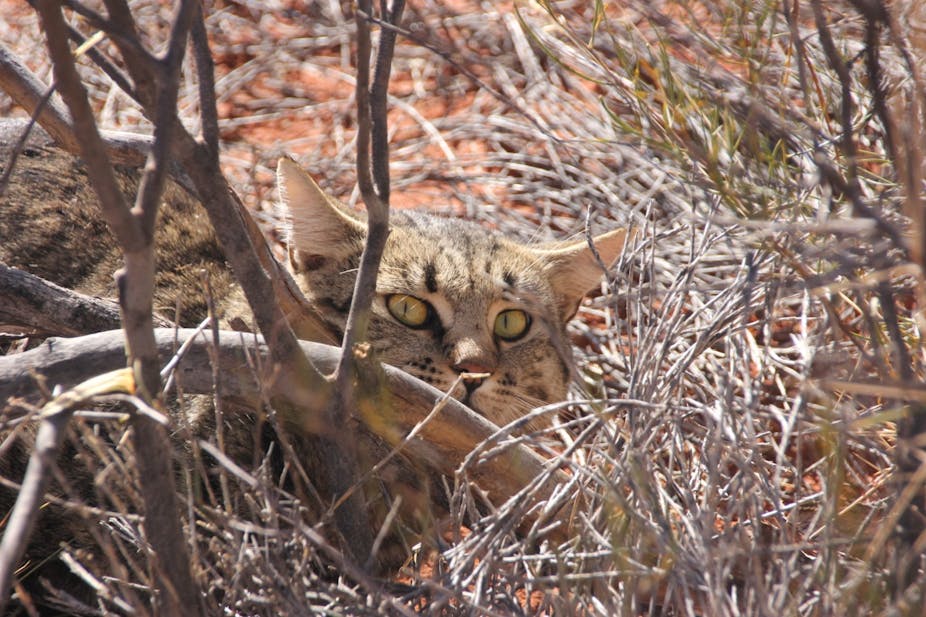During a speech in Parliament on October 17 1996 — 18 years ago today — then Liberal MP Richard Evans called for the “total eradication of domestic and feral cats from the Australian mainland and offshore islands by the year 2020”.
Similarly, Federal Environment Minister Greg Hunt last week announced a 10-year plan to eradicate “all of the significant populations of feral cats around Australia”.
There has also been a lot of media recently about feral cats in Australia, including: Radio National’s Background Briefing, ABC Online, the Sydney Morning Herald, Radio National’s Bush Telegraph and The Australian
It’s great that the national conversation is gaining momentum on this issue. Australia has lost 30 mammal species to extinction in just over 200 years, which is the worst mammal extinction record anywhere in the world. According to Professor John Woinarski at Charles Darwin University, at least 20 of these can be attributed to cats.
A recent wave of mammal declines in parts of northern Australia, such as Kakadu National Park, has sparked a renewed call for action on feral cats.
But how many cats are out there? If we look at the evidence, we really don’t know.

Twisted tales
The media around this topic often quotes a feral cat population estimate that their followers can grab onto. I’m even guilty of it myself.
The SMH article above quotes the Australian Wildlife Conservancy (AWC) in saying there are an estimated 15 million feral cats in Australia and the Background Briefing report says there are an estimated 15 to 23 million cats.
AWC says that cats eat between five and 30 native animals a night and then they multiply this figure of five by 15 million cats to estimate that feral cats eat 75 million native animals each night.
Similarly, in a follow up to the Background Briefing report, the ABC’s Gregg Borschmann is quoted as saying “Did you know there’s 20 million of them out there, and every one of them eats five critters a night. That’s 20 billion native animals a year” (although my calculations make this closer to 40 billion).
The assumption that cats eat five native animals each night may hold true in northern Australia where European rabbits are largely absent, but it won’t always stand up in the southern half of the continent where rabbits form a staple part of cats’ diets in many areas. These are only estimates of course and they’re useful for engaging the wider community in the feral cat discussion.
A number of news reports also state that the recent Action Plan for Australian Mammals estimated that there are 15 million feral cats in Australia. I’ve read the main sections of this 1,000 page book, and I don’t believe this to be the case. It appears that these numbers are becoming conflated as they filter through various media reports.
Nevertheless, these massive numbers are great for capturing the attention of the general public and raising awareness about feral cat impacts. But from a scientific point of view, it’s important to ask how reliable these estimates are.
What do scientists say?
Professor David Pimentel and colleagues at Cornell University in 2001 quoted a figure of 18 million feral cats in Australia, with the reference being an anonymous 1996 New Zealand newspaper article.
Then in 2004 a Pest Animal Control CRC report cited Pimentel for the figure of 18 million cats and in 2008 the Commonwealth Threat Abatement Plan for predation by feral cats cited the 2004 report also for the figure of 18 million.
In their 2010 report, Dr Elizabeth Denny and Professor Chris Dickman stated the following: "Pimentel et al (2001) estimated that there are approximately 18 million feral cats in Australia, although the accuracy of this estimation is unknown".
The series of reports detailed above are all relying on a single citation of an anonymous 1996 New Zealand newspaper article.
The newspaper article in question takes its figure of 18 million from the same Parliament speech by MP Richard Evans on October 17 1996 that called for the eradication of feral cats. Evans also quoted figures of 5 and 12 million, but took the figure of 18 million from a 1993 NSW Parliament speech by then state Labor MP Bob Martin where he stated “Wildlife experts state that between 5.6 million and 18.4 million of these animals are roaming Australia”.
A number of sources incorrectly cite a 1991 report for those figures, which seem to have come from this 1993 pamphlet. In turn, the pamphlet doesn’t say where it took its numbers from. Wherever they came from, these figures seem to be the best estimate we have.

Where to from here?
Calculating an absolute number of feral cats in Australia is a very difficult exercise. Australia is a vast and diverse continent, both spatially and temporally.
Estimates of cat population densities range from 0.03 to 4.7 cats per square kilometre in relatively unmodified and pastoral landscapes, and from 0.7 to 800 cats per square kilometre in highly modified landscapes, such as rubbish dumps.
Extrapolating these figures across the entire continent would yield some fairly wide confidence intervals. Taking a conservative estimate of 1 cat per square kilometre across the entire continent would amount to nearly 8 million cats.
But calculating a more reliable estimate would involve using different density estimates for different climatic regions and would also need to consider inter-annual variation caused by rainfall.
I haven’t attempted to do this, nor do I seek to put forward a better estimate here. However, I think it’s important that we think about this more closely, especially given Greg Hunt’s decade-long feral cat eradication plan. How can we eradicate feral cats if we don’t know how many there are?
This article was updated October 17 to replace the map with a more accurate version.

